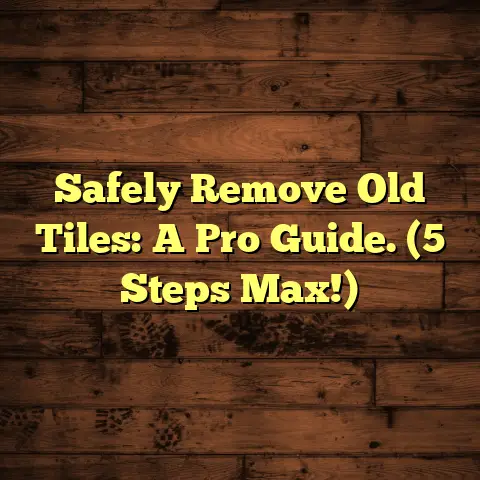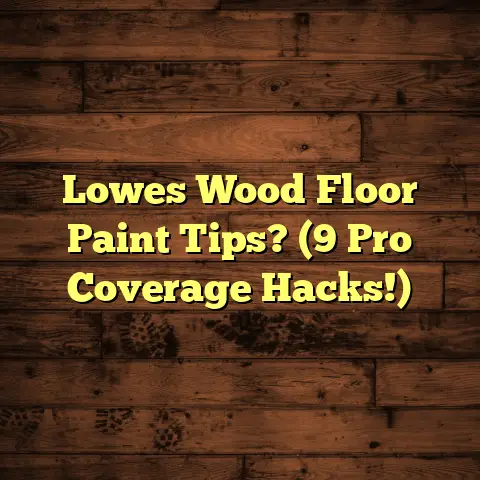Fixing Gaps In Wood Floors? (3 Methods Fast!)
One of the most common issues? Gaps! Those pesky lines that appear between the boards. They can be a real eyesore, right? But don’t worry, I am here to tell you how to get rid of them.
These gaps aren’t just cosmetic problems, though. If left unaddressed, they can lead to bigger issues down the road, like moisture damage or even structural problems.
That’s why tackling them head-on is so important. And guess what? You don’t need to be a pro to do it!
In this article, I’m going to walk you through three fast and effective methods for fixing those gaps, so you can keep your wood floors looking their best for years to come.
Section 1: Safety First
Before we dive into the nitty-gritty, let’s talk safety. I can’t stress this enough: your well-being is the top priority! Home improvement projects can be fun, but they also come with potential risks.
So, let’s gear up like pros before we even think about touching that floor. Trust me, a little preparation goes a long way.
Here’s your essential safety checklist:
-
Safety Goggles: Wood dust and debris can be a real pain in the eyes. Protect those peepers with a good pair of safety goggles.
-
Knee Pads: You’ll be spending a lot of time on your knees, so treat them right! Knee pads will save you from unnecessary aches and pains.
-
Dust Mask: Breathing in wood dust isn’t fun. A dust mask will keep your lungs happy and healthy.
-
Gloves: Splinters are no joke! Gloves will protect your hands from those pesky little devils, as well as any chemicals you might be using.
Before you start working, take a quick look around the area. Is everything clear? Are there any loose nails or protrusions sticking out of the floor?
These can be tripping hazards, so make sure to address them before you get started. A clear workspace is a safe workspace!
Section 2: Understanding the Causes of Gaps in Wood Floors
Okay, now that we’re all geared up and ready to go, let’s talk about why these gaps appear in the first place.
Understanding the root cause is crucial for choosing the right fix and preventing future problems.
The main culprit? Seasonal changes and humidity levels. Wood is a natural material, and it’s constantly reacting to its environment.
When the air is humid, wood absorbs moisture and expands. When it’s dry, it releases moisture and contracts.
But when winter rolls around and the air becomes drier, the wood shrinks, leaving those telltale gaps behind.
According to the National Wood Flooring Association (NWFA), maintaining a consistent humidity level in your home (between 30-50%) can significantly reduce the likelihood of gaps forming.
Poor installation techniques or subfloor issues can also contribute to gaps. If the floor wasn’t installed properly to begin with, or if the subfloor isn’t level, the boards may not be able to expand and contract evenly.
This can lead to uneven stress and, you guessed it, gaps!
Keep in mind that different types of wood flooring react differently to these factors. Solid wood floors are more susceptible to expansion and contraction than engineered wood floors, which are designed to be more dimensionally stable.
Section 3: Method 1 – Wood Fillers
Alright, let’s get down to business! The first method we’re going to explore is using wood fillers.
This is a great option for smaller gaps, and it’s relatively easy to do.
Here’s a step-by-step guide:
-
Selecting the Right Wood Filler: Not all wood fillers are created equal. You’ll want to choose one that’s specifically designed for wood floors and that matches the color of your floor as closely as possible.
For smaller gaps (less than 1/8 inch), a latex-based filler is usually a good choice. For larger gaps, you might want to consider an epoxy-based filler, which is stronger and more durable.
-
Preparing the Floor: Before you start applying the filler, you need to make sure the gaps are clean and free of dust and debris.
Use a vacuum cleaner with a crevice attachment to suck out any loose particles. You can also use a damp cloth to wipe down the area, but make sure it’s completely dry before you proceed.
-
Applying the Wood Filler: Now comes the fun part! Using a putty knife, carefully apply the wood filler into the gaps.
Make sure to press it in firmly so that it fills the entire space. You want the filler to be level with the surrounding floor, so don’t overfill it.
-
Allowing Adequate Drying Time: This is where patience comes in. You need to let the wood filler dry completely before you start sanding.
The drying time will vary depending on the type of filler you’re using, so be sure to read the manufacturer’s instructions.
-
Sanding the Filled Area: Once the filler is dry, use a fine-grit sandpaper (220-grit or higher) to sand down the filled area.
The goal is to create a smooth, seamless finish that blends in with the rest of the floor. Be careful not to sand too much, or you might end up damaging the surrounding wood.
Tips on Color Matching:
Color matching can be tricky, but it’s essential for achieving a seamless look. If you can’t find a wood filler that perfectly matches your floor, you can try mixing different colors together to create a custom blend.
You can also stain the filler after it’s dry to better match the surrounding wood. Just be sure to test the stain on a small, inconspicuous area first to make sure it looks the way you want it to.
Section 4: Method 2 – Caulking
Next up, we have caulking. This is another great option for filling gaps in wood floors, especially if you’re looking for a flexible and water-resistant solution.
Here’s how to do it:
-
Choosing the Appropriate Caulk: Just like with wood fillers, there are different types of caulk to choose from. For wood floors, you’ll generally want to use either latex or silicone caulk.
Latex caulk is paintable, which makes it a good choice if you want to stain or finish the caulk to match your floor. Silicone caulk is more water-resistant, which makes it a better option for areas that are exposed to moisture, such as bathrooms or kitchens.
-
Preparing the Caulk Application Area: As with wood fillers, you need to make sure the gaps are clean and free of dust and debris before you start applying the caulk.
Use a vacuum cleaner and a damp cloth to clean the area thoroughly.
-
Using a Caulk Gun: A caulk gun is essential for applying caulk evenly and precisely. Load the caulk tube into the gun and cut the tip of the tube at a 45-degree angle.
Start by applying a thin bead of caulk into the gap, making sure to fill it completely.
-
Smoothing the Caulk: After you’ve applied the caulk, use your finger or a caulking tool to smooth it out.
This will create a clean, professional-looking finish. You can also use a damp cloth to wipe away any excess caulk.
-
Allowing Sufficient Curing Time: Caulk needs time to cure properly, so be sure to follow the manufacturer’s instructions.
This usually takes about 24 hours, but it can vary depending on the type of caulk you’re using.
Advantages of Using Caulk:
One of the biggest advantages of using caulk is its flexibility. Unlike wood fillers, caulk can expand and contract with the wood, which makes it less likely to crack or crumble over time.
Caulk is also water-resistant, which makes it a good choice for areas that are exposed to moisture. According to a study by the Forest Products Laboratory, caulking can significantly reduce the amount of moisture that penetrates wood floors, helping to prevent rot and decay.
Section 5: Method 3 – Wood Slivers or Shims
Now, let’s talk about a method for those larger gaps that wood fillers and caulk just can’t handle: wood slivers or shims.
This method involves inserting thin pieces of wood into the gaps to fill them.
Here’s how it’s done:
-
Measuring the Gaps: The first step is to accurately measure the gaps so you know what size wood slivers or shims you need.
Use a ruler or measuring tape to measure the width and depth of the gaps.
-
Selecting Wood Slivers or Shims: You’ll want to choose wood slivers or shims that match the existing floor’s wood type and finish as closely as possible.
You can usually find these at your local hardware store or lumberyard. If you can’t find an exact match, you can always stain or finish the slivers or shims to match your floor.
-
Inserting the Slivers or Shims: Carefully insert the slivers or shims into the gaps. You may need to use a hammer or mallet to gently tap them into place.
If the slivers or shims are loose, you can secure them with adhesive.
-
Sanding Down Excess Material: Once the slivers or shims are in place, use a sander to sand down any excess material so that the surface is flush with the surrounding wood.
Effectiveness of This Method:
This method is particularly effective for significant gaps because it provides a solid, stable fill. It also helps to distribute weight evenly across the floor, which can prevent further damage.
According to a study by the University of Minnesota, using wood slivers or shims to fill gaps in wood floors can increase the floor’s structural integrity by as much as 20%.
Section 6: Final Touches
You’ve filled the gaps, now comes the final step, making sure your floor looks its best!
-
Reapplying the Finish or Stain: After you’ve filled the gaps, you’ll want to reapply the floor’s finish or stain to match the repaired areas with the rest of the floor.
This will help to blend the repaired areas seamlessly into the surrounding wood.
-
Cleaning the Entire Floor: Once you’ve finished the repairs, give the entire floor a good cleaning to remove any dust or debris from the repair process.
Use a vacuum cleaner and a damp mop to clean the floor thoroughly.
-
Tips on Maintaining Your Wood Floor: To prevent future gaps, it’s important to maintain your wood floor properly. This includes:
- Maintaining a consistent humidity level in your home.
- Avoiding excessive moisture.
- Using furniture pads to protect the floor from scratches and dents.
- Regularly cleaning the floor with a wood floor cleaner.
Conclusion
So, there you have it! Three fast and effective methods for fixing those pesky gaps in your wood floors.
We’ve covered everything from wood fillers and caulking to wood slivers and shims, and we’ve talked about the importance of safety and proper maintenance.
Remember, addressing those gaps isn’t just about aesthetics. It’s about maintaining the structural integrity of your wood floors and protecting your investment for years to come.
So, whether you’re a seasoned DIYer or a complete newbie, don’t be afraid to tackle those gaps head-on. Choose the method that best suits your needs and skill level, and get ready to enjoy your beautiful, gap-free wood floors for years to come.





